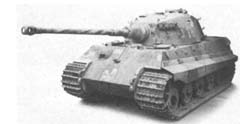Hitler's favorite tank sits rusting on a dumping ground in the Russian province
Tank that is on display in one of the provincial museums can be worth tens of millions of dollars
 It is hardly a surprise that some specimens of vintage military equipment still scattered across Russia are impossible to evaluate. The tank that used to stir up an argument between the two Russian governors falls under the priceless military artifacts category dating back to WWII. Some sources indicate that the Tiger in question was Adolf Hitler's favorite toy, according to Versia.
It is hardly a surprise that some specimens of vintage military equipment still scattered across Russia are impossible to evaluate. The tank that used to stir up an argument between the two Russian governors falls under the priceless military artifacts category dating back to WWII. Some sources indicate that the Tiger in question was Adolf Hitler's favorite toy, according to Versia.
The refusal of the former Saratov governor Dmitry Ayatskov to return the tank to the Istra museum of military equipment, the place it had been borrowed by Mr. Ayatskov in 2001, gave rise to a lot of fuss over the rusty Nazi “monster.” Mr. Ayatskov and the governor of the Moscow region Boris Gromov were involved in litigation for several years. Finally, the case was closed and the tank returned to its original location in the museum of military equipment. According to a source sited by Vesti, the tank had been slightly vandalized while in the Saratov museum. The tank's numbers and crosses had been gone.
The Tiger became a museum exhibit in 1973. Yuri Nikitin discovered it sitting in a bog in the Moscow region. There were five American Shermans, a heavy Tiger, a half-crippled Panther and some old Soviet tanks stuck in the mire on the edge of an abandoned tank range located in Nakhabino. As it turned out, the Tiger was seized near the village Sinyavino at the Leningrad front and sent straight to the tank range. Mr. Nikitin was quick to realize that he had come across a real treasure. He knew that there was only one Tiger in the Kubinka museum. Other tanks of this class were thought to have been destroyed.
The Germans used Tigers on the Leningrad front just once. They brought six tanks into action on September 21st, 1942. Therefore, the Tiger found in the bog is one out of six German tanks that came under fire while moving along the road Mga-Sinyavino. The first battery of 1225 Soviet howitzer regiment fired at the tanks on that day.
The event entered the memoirs of Albert Speer, a minister weapons and ammunition of the Third Reich. According to him, at the break of day on September 21st, 1942, six Tigres accompanied by a light tank T-III began crawling along the narrow dam built over the bog. There was not enough room for maneuvering. The light tank was heading the column. No sooner had the German tanks approached the positions of the Soviet troops than the head tank was hit and burned down. Then the Tiger at the end of the column was hit and its engine stalled. The remaining Tigers were destroyed within a few minutes. The Germans could not recover them since the Soviet howitzers kept firing away.
According to Mr. Speer's memoirs, Hitler was closely following the combat baptism of the new tanks. He demanded an hourly report on the situation. Hitler flew into a rage when he found out that the attack was a disgrace. He demanded all tanks should be smashed into pieces so that the enemy could never get a hold in the German secret weapon. The Germans managed to blow off four tanks. However, the Soviets had already removed two tanks using tractors. One of them was delivered totheNakhabinotankrange.Sovietdesignerspainstakinglyexamined the specimen and learned the important combat specifications of the Tiger by the summer of 1943.
Researchers point out that the Tiger from the Istra museum is a very rare version, the so-called “African version.” Bearing in mind the rare version of the tank and the location where it was hit by the Soviet artillery, we can assert that the Tiger was made under personal supervision of Dr. Ferdinand Porsche. Its value can be on a par with that of the famous pink Cadillac that used to belong to the King of Rock and Roll Elvis Presley, reports Versia.
The newspaper puts forth the following facts to prove the point. Hitler ordered two companies – Henschel and Porsche – to build a heavy tank by the summer of 1942. Both versions were delivered for display to Hitler's headquarters The Wolfe’s Lair near the city of Vinnitsa in Ukraine. The Tiger by Dr. Porsche had to be repaired a few times during the railway trip to Vinnitsa, mechanics were in a hurry and fixed the malfunctions in field conditions.
Despite all the trouble and worry on the road, Hitler spent a mere two minutes examining the Henschel Tiger. On the contrary, once he caught a glimpse of the Porsche Tiger, he began to look like a child who just got his favorite toy. He examined the tank for nearly an hour complimenting on its technical novelties. Then he went on to speculate at length about the future battles won by the tank and the Russian artillery positions squashed by the invincible German monster.
At the end of the day, the version designed by Henschel was chosen for series production because the majority of the Fuhrer's advisers and generals from the General Staff were lobbying the more successful model. Besides, the tank engine designed by Porsche had an air cooling system that was far too much complicated for the assembly line. Anyway, Hitler asked Dr. Porshe to produce a few similar Tiger to be used in Africa.
According to Vesti, an exclusive version of the Tiger by Porsche took part in the combat operation near the railway station Mga. The tank went into action along with the first five Tigers manufactured by Henschel in series. The Tiger that was fired upon in the Sinyavino bog and later was left to rust in the open for decades, it seems to be the very tank Adolf Hitler was so enthusiastic about.
Visitors to the Istra museum could see the degree of damage inflicted on the famous tank. Its track links disappeared during the “Saratov captivity,” its cannon was sawn off and its engine needs completing. But identification of the tank can still be done by using serial numbers on the body and engine. The German archives should keep the passport showing the movements of the tanks and information regarding the crew.
Experts estimate that the price tag for a tank of the class T-VI Tiger (even if the tank is in a pretty bad shape) is in the neighborhood of $1.5 million. The sum should at least double if the tank is sold on an auction. Given the rare version and a personal “relationship” with the Fuhrer, the tank can fetch tens of millions of dollars, reports Vesti.
Subscribe to Pravda.Ru Telegram channel, Facebook, RSS!





